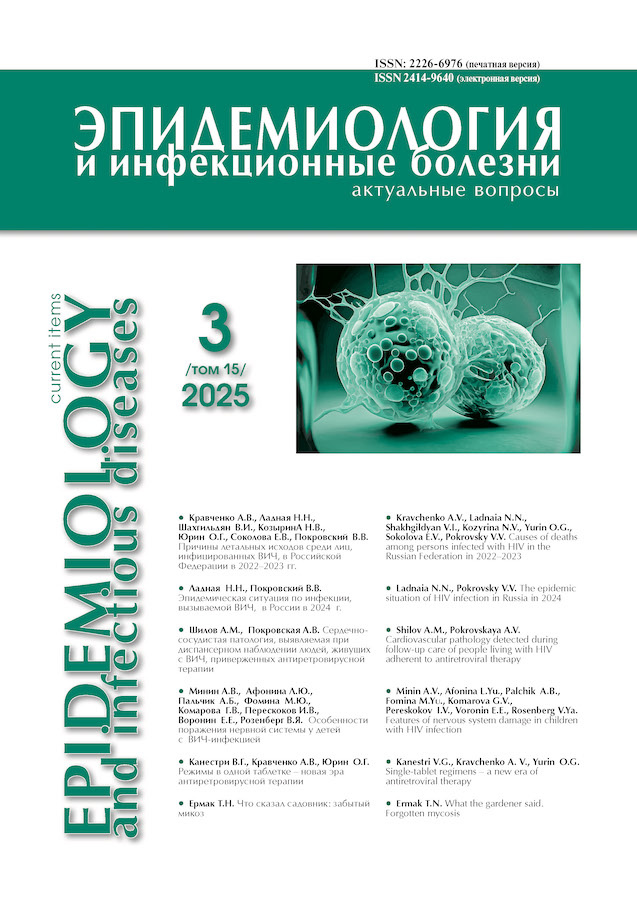Prevalence of serological markers of hepatitis B and assessment of the level of immunization against hepatitis virus among HIV-infected persons
- Autores: Efremova O.S.1, Pokrovskaya A.V.1,2
-
Afiliações:
- Central Research Institute of Epidemiology, Russian Federal Service for Supervision of Consumer Rights Protection and Human Well-Being
- Peoples’ Friendship University of Russia named after Patrice Lumumba
- Edição: Volume 15, Nº 3 (2025)
- Páginas: 24-27
- Seção: Epidemic Situation
- URL: https://journals.eco-vector.com/2226-6976/article/view/691554
- DOI: https://doi.org/10.18565/epidem.2025.15.3.24-27
- ID: 691554
Citar
Texto integral
Resumo
Objective. Assessment of the state of immunity against hepatitis B virus among HIV-infected individuals.
Materials and methods. The study included HIV-infected patients undergoing follow-up care at the Central Research Institute of Epidemiology, Russian Federal Service for Supervision of Consumer Rights Protection and Human Well-Being. The study was conducted from October 2022 to September 2023. Laboratory examination of patients included: determination of the CD4+ lymphocyte number, the blood HIV RNA level, and serological markers of hepatitis B.
Results. 417 patients , including 274 (65.7%) men, were examined. The age of the patients ranged from 20 to 73 years, the mean age was 43 years. Current hepatitis B virus (HBV) infection was recorded in 10 (2.4%) patients. Previous hepatitis B was detected in 74 (18.2%) patients, latent or hidden HBV infection – in 38 (9.3%). 116 (28.5%) people were vaccinated against HBV. The number of participants not immune to HBV infection was 179 (44%).
Conclusion. The obtained results showed low coverage of vaccination against HBV among HIV-infected patients. Measures to increase the effectiveness and availability of vaccination are required.
Texto integral
Sobre autores
Oksana Efremova
Central Research Institute of Epidemiology, Russian Federal Service for Supervision of Consumer Rights Protection and Human Well-Being
Autor responsável pela correspondência
Email: ks517@yandex.ru
ORCID ID: 0000-0001-5037-4041
Cand. Med. Sci., Infectiologist, Researcher
Rússia, MoscowAnastasia Pokrovskaya
Central Research Institute of Epidemiology, Russian Federal Service for Supervision of Consumer Rights Protection and Human Well-Being; Peoples’ Friendship University of Russia named after Patrice Lumumba
Email: pokrovskaya@cmd.su
ORCID ID: 0000-0002-2677-0404
MD, Senior Researcher, Central Research Institute of Epidemiology, Associate Professor, Department of Infectious Diseases with Courses of Epidemiology and Phthisiology, Medical Institute
Rússia, Moscow; MoscowBibliografia
- Покровский В.В., Ладная Н.Н., Киреев Д.Е., Хохлова О.Н., Серебровская Л.В., Покровская А.В. и др. Лекции по ВИЧ-инфекции. 2-е изд., перераб. и доп. М.: ГЭОТАР-Медиа, 2018; 396–424. Pokrovsky V.V., Ladnaya N.N., Kireev D.E., Khokhlova O.N., Serebrovskaya L.V., Pokrovskaya A.V. et al. [Lectures on HIV infection]. 2nd ed., revised and expanded. Moscow: GEOTAR-Media, 2018; 396–424 (In Russ.).
- Tarantola A., Abiteboul D., Rachline A. Infection risks following accidental exposure to blood or body fluids in health care workers: A review of pathogens transmitted in published cases. Amer. J. Infect. Control. 2006; 34(6): 367–375. doi: 10.1016/j.ajic.2004.11.011
- Thio C.L., Seaberg E.C., Skolasky R.Jr., Phar J., Visscher B., Muñoz A. et al. HIV-1, hepatitis B virus and risk of liver-related mortality in the Multicenter Cohort Study (MACS). Lancet 2002; 360(9349): 1921–1926. doi: 10.1016/s0140-6736(02)11913-1
- Konopnicki D., Mocroft A., Antunes F., Ledergerber B., Ledergerber B., Katlama C. et al. Hepatitis B and HIV: prevalence, AIDS progression, response to highly active antiretroviral therapy and increased mortality in the EuroSIDA cohort. AIDS 2005; 19(6): 593–601. doi: 10.1097/01.aids.0000163936.99401.fe
- Li Wu., Wang X., Li T. Coinfection with hepatitis B virus/human immunodeficiency virus: the interaction between infection caused by human immunodeficiency virus, chronic infection caused by hepatitis B virus, and host immunity. Chin. Med. J. 2012; 125(13): 2371–2377. doi: 10.3760/cma.j.issn.0366-6999.2012.13.023
- Kim D.K., Riley L.E., Harriman K.H., Hunter P., Bridges C.B. Advisory Committee on Immunization Practices Recommended immunization schedule for adults aged 19 years or older United States. MMWR Morb Mortal Wkly Rep. 2017; 66(5): 136–138. doi: 10.15585/mmwr. mm6605e2
- Rubin L.G., Levin M.J., Jungman P., Davies E.G., Avery R., Tomblyn M. et al. The 2013 IDSA Clinical Practice Guide for Immunocompromised Host Vaccination. Clin. Infect. Dis. 2014; 58(3): 309–318. doi: 10.1093/cid/cit816
- Покровский В.В., Юрин О.Г., Кравченко А.В., Беляева В.В., Буравцова Е.В., Деулина М.О. и др. Рекомендации по лечению ВИЧ-инфекции и связанных с ней заболеваний, химиопрофилактике заражения ВИЧ. Эпидемиол. инфекц. болезни. Актуал. вопр. 2023; 12(4, приложение). 109 с. Pokrovsky V.V., Yurin O.G., Kravchenko A.V., Belyaeva V.V., Buravtsova E.V., Deulina M.O. et al. [Recommendations for the treatment of HIV infection and related diseases, chemoprophylaxis of HIV infection]. Epidemiology and infectious diseases. Current items 2023; 12(4, application). 109 р. (In Russ.).
- Кравченко А.В., Куимова У.А., Покровская А.В., Голиусова М.Д. Частота обнаружения маркеров гепатита B у больных ВИЧ-инфекцией, тактика ведения пациентов. Журнал инфектологии 2020; 12(3): 59–63. doi: 10.22625/2072-6732-2020-12-3. Kravchenko A.V., Kuimova U.A., Pokrovskaya A.V., Goliusova M.D. [The frequency of detection of hepatitis B markers in patients with HIV infection, tactics of patient management]. J. Infectol. 2020; 12(3): 59–63. (In Russ.). doi: 10.22625/2072-6732-2020-12-3.
Arquivos suplementares










